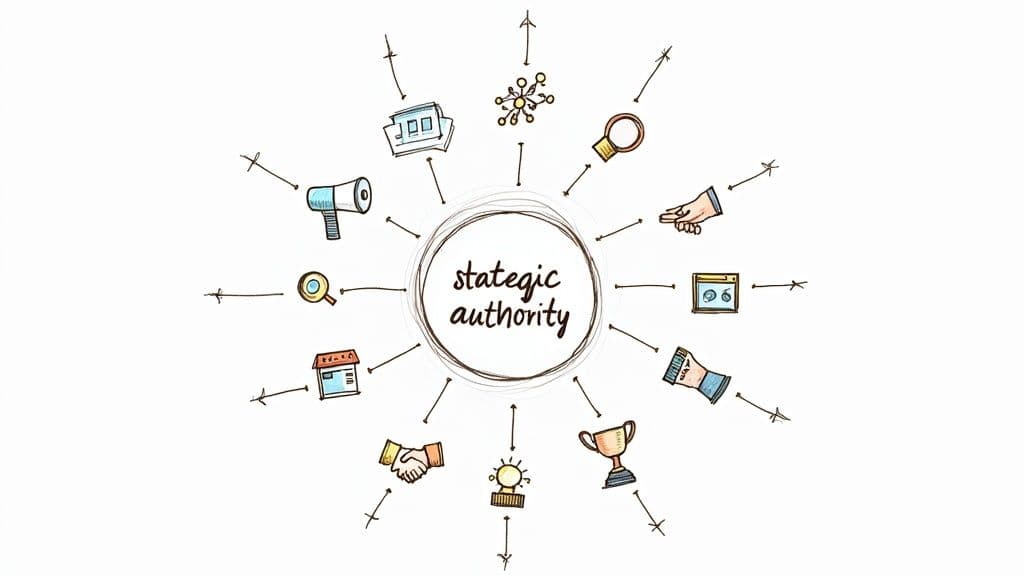Top B2B Public Relations Strategies for 2025 Success
October 7, 2025

In the complex world of B2B, sales cycles are long, trust is paramount, and decisions are made by committees, not impulse. This is where strategic public relations transcends simple press releases and becomes a critical driver of market leadership. Effective b2b public relations strategies don't just generate awareness; they build the foundational credibility, third-party validation, and expert positioning that influence high-stakes purchasing decisions. Forget fleeting buzz and focus on building lasting authority that directly supports sales and C-suite objectives.
This article moves beyond generic advice to provide a deep dive into nine proven strategies designed for today’s competitive B2B environment. We will explore actionable frameworks for everything from cultivating relationships with industry analysts to leveraging original data for high-impact media coverage. You will learn how to amplify customer success stories, secure prestigious awards, and establish your executives as go-to thought leaders.
Whether you're a SaaS startup seeking investor attention, a FinTech innovator building market trust, or an established enterprise defending your position, mastering these approaches is essential. The following list provides the specific tactics you need to shape industry conversations, attract high-quality leads, and build a brand that commands respect in your niche.
1. Thought Leadership Content Marketing
One of the most effective b2b public relations strategies is to position your company's leaders as industry authorities. Thought leadership content marketing involves your executives sharing unique, forward-thinking insights on industry trends, challenges, and future predictions. This strategy elevates your brand from a mere vendor to a trusted advisor, building deep credibility that is crucial in long B2B sales cycles where expertise and trust are paramount.

Consider how HubSpot’s co-founder, Brian Halligan, effectively coined and popularized the term 'inbound marketing'. By creating a wealth of educational content around this concept, he established both his personal authority and HubSpot's dominance in the marketing technology space. Similarly, Microsoft's Satya Nadella shifted public perception by championing cloud computing and AI transformation, positioning Microsoft as an innovative leader.
How to Implement This Strategy
To execute this effectively, you must move beyond generic advice and develop a distinct point of view.
- Identify a Niche Angle: Find a unique perspective or a "white space" in your industry's conversation that your executives can credibly own.
- Create an Editorial Calendar: Align your content publication with key industry events, news cycles, and product launches to maximize relevance and impact.
- Maintain an Authentic Voice: While it's common to ghost-write initial drafts, ensure your executive thoroughly reviews and refines the content to reflect their genuine voice and expertise.
- Repurpose Strategically: A single powerful insight from a keynote speech can be repurposed into a LinkedIn article, a series of social media posts, a blog entry, and a short video clip. This multi-channel approach amplifies your message. For a deeper dive into content creation, you can explore specialized guides on content marketing for tech companies.
Key Insight: The goal isn't just to add to the noise, but to become the signal. True thought leadership shapes the conversation, it doesn't just participate in it. Track metrics like share of voice and media sentiment to measure your influence accurately.
2. Industry Analyst Relations
A highly specialized and powerful b2b public relations strategy is building relationships with influential industry analysts. Analyst Relations (AR) focuses on engaging with firms like Gartner, Forrester, and IDC whose research, reports, and advisory services heavily influence enterprise purchasing decisions. Positive placement in a Gartner Magic Quadrant or Forrester Wave report acts as a powerful third-party endorsement, validating your solution for B2B buyers who rely on this expert guidance to navigate complex technology landscapes.

Consider how Salesforce's consistent leadership positioning in Gartner's CRM reports has cemented its market dominance, making it a default choice for many enterprises. Similarly, UiPath effectively used analyst relations to define and then lead the emerging Robotic Process Automation (RPA) category, educating both the market and potential buyers through analyst reports. This strategy provides crucial credibility, especially for companies defining new markets or challenging established incumbents.
How to Implement This Strategy
A successful AR program is built on consistent, transparent, and strategic communication, not just occasional briefings around a launch.
- Assign a Dedicated AR Lead: Consistency is key. Assign a specific person or team to manage analyst relationships, ensuring a single point of contact and steady engagement.
- Brief Analysts Proactively: Schedule regular briefings (e.g., quarterly) to share roadmap updates, company momentum, and market insights, even when you don't have major news. This keeps you top-of-mind.
- Be Transparent and Honest: Build trust by being upfront about product limitations or roadmap gaps. Analysts value this transparency and are more likely to see you as a credible source.
- Leverage Customer References: The most powerful tool in your AR toolkit is a happy customer. Provide analysts with direct access to clients who can validate your claims and showcase real-world success. You can find more tactical advice on managing these relationships in guides about building an analyst relations program.
Key Insight: Analyst relations is a two-way street. It's not just about influencing analysts; it's also about listening to them. Use their feedback, gleaned from inquiries and briefings, to inform your product strategy and better understand buyer priorities.
3. Strategic Media Relations and Trade Publication Outreach
A cornerstone of effective b2b public relations strategies is building sustained relationships with journalists, editors, and reporters who cover your industry. Unlike broad consumer PR, this approach is highly targeted, focusing on trade publications, business media, and specialized outlets. The goal is to secure coverage that highlights your company's business impact, industry expertise, and innovation for a professional audience of decision-makers.

Consider how Slack executed its pre-launch media strategy, securing over 8,000 signups before it was even publicly available by focusing on targeted tech media coverage. Similarly, Stripe gained immense credibility through strategic features in outlets like TechCrunch and Business Insider, which emphasized its developer-first positioning and solidified its reputation among a critical early-adopter audience.
How to Implement This Strategy
A successful media outreach plan prioritizes quality over quantity, focusing on building genuine connections.
- Create a Targeted Media List: Forget massive databases. Identify 20-30 key journalists and publications that your ideal customers actually read and trust.
- Lead with Data, Not Products: Frame your pitches around compelling data, unique industry trends, or exclusive insights. Product features should support the story, not be the story.
- Offer Exclusivity Strategically: For major announcements, offer an exclusive story to a top-tier publication to secure a more in-depth, high-impact feature.
- Be Responsive and Proactive: Use tools like HARO (Help A Reporter Out) to provide expert commentary on relevant topics and respond to journalist inquiries promptly. For a more comprehensive look at this discipline, you can explore detailed guides on what is media relations.
Key Insight: In B2B media relations, you're not just pitching a story; you're offering a valuable resource. Your long-term goal is to become a trusted source that journalists turn to for expert commentary, which provides far more value than a single press release.
4. Customer Success Story Amplification
One of the most potent b2b public relations strategies is to transform customer success into powerful third-party validation. This involves identifying, documenting, and strategically promoting detailed case studies and testimonials that showcase tangible business results. In B2B, peer proof is paramount; decision-makers are far more convinced by a story of how a similar company solved a shared problem than by any marketing claim. PR's role is to amplify these stories beyond your website, placing them in industry publications and trade media where they gain immense credibility.

Consider how AWS masterfully uses customer stories from Netflix and NASA to demonstrate its scalability and reliability, effectively building trust with other enterprise clients. Similarly, Workday highlights major business transformations at well-known companies like HP, providing concrete evidence of its platform's value. These examples serve as powerful social proof that resonates deeply with prospective buyers who see their own challenges reflected in the narrative.
How to Implement This Strategy
To make this work, you must move from simple testimonials to compelling, data-backed narratives that your PR team can effectively pitch.
- Prioritize High-Impact Stories: Focus on customers with strong brand recognition or those who have achieved remarkable, quantifiable results that will grab media attention.
- Structure for Impact, Not Features: Frame each story around the customer's initial business challenge, the solution implemented, and the specific outcomes. The focus should always be on their success, not just your product's capabilities.
- Quantify Everything: Use specific metrics. "Achieved a 50% reduction in operational costs" is far more powerful and newsworthy than "generated significant savings."
- Create Versatile Assets: Repurpose a single success story into multiple formats: a detailed written case study for your website, a short video testimonial for social media, an infographic for presentations, and a quote for press releases.
Key Insight: A customer success story is not just marketing collateral; it's a PR asset. When a trusted industry journal publishes your customer's story, it becomes an objective endorsement, providing validation that money can't buy. Track placements and referral traffic from these features to measure their direct impact.
5. Original Research and Data-Driven PR
One of the most powerful b2b public relations strategies is to become the source of new information. This involves conducting and publishing original research, surveys, or data analysis that offers unique insights into your industry. By creating proprietary data, your company generates inherently newsworthy content that establishes you as a primary source, attracts high-quality media coverage, and fuels your content marketing engine for months.
For example, Salesforce’s annual 'State of Marketing' report is now a go-to resource for industry trends, generating countless media mentions and reinforcing their authority. Similarly, HubSpot's 'State of Inbound' research not only drives leads but also positions them at the center of the inbound marketing conversation. These companies don’t just comment on trends; they create the data that defines them.
How to Implement This Strategy
To succeed with data-driven PR, the quality and credibility of your research are paramount.
- Ensure Statistical Significance: Aim to survey a minimum of 500 respondents to ensure your data is credible and can withstand journalistic scrutiny.
- Create an Embargoed Rollout: Grant top-tier journalists exclusive, early access to your report under an embargo. This strategy builds relationships and often secures more in-depth coverage on launch day.
- Slice the Data for Longevity: A single comprehensive report can be broken down into multiple smaller stories and press releases. Focus on different angles, industries, or demographics to extend the news cycle.
- Develop a Consistent Cadence: Turn your research into an annual or bi-annual event. This builds anticipation and establishes your report as a benchmark study that journalists and industry professionals look forward to each year.
Key Insight: Proprietary data is a defensible asset. While competitors can copy product features, they cannot replicate your unique findings. This strategy transforms your PR from a cost center into a long-term asset that generates backlinks, media authority, and sales enablement material.
6. Strategic Partnership and Co-Marketing PR
Another of the most powerful b2b public relations strategies involves leveraging the credibility and reach of complementary companies. Strategic partnerships and co-marketing PR create a "one plus one equals three" effect, where aligning with another brand allows you to access new audiences, share credibility, and generate compelling, newsworthy announcements that would be impossible to create alone. This approach is particularly effective for startups seeking to associate with established industry players.
A prime example is Salesforce’s extensive AppExchange, which creates a constant stream of PR opportunities through partner announcements. Similarly, Slack’s numerous integrations with platforms like Google and Atlassian were pivotal in positioning it as the central hub of workplace communication. These partnerships aren't just features; they are strategic PR events that validate a company's ecosystem and value proposition.
How to Implement This Strategy
A successful partnership PR campaign is built on mutual benefit and clear, proactive communication.
- Select Partners Strategically: Identify companies whose audiences overlap with your target market but who are not direct competitors. A strong value alignment is key.
- Formalize PR in Agreements: Don't treat PR as an afterthought. Negotiate and include specific PR rights, roles, and approval processes directly in the partnership agreement.
- Develop a Joint Launch Plan: Create a shared PR timeline that outlines key messages, target media, and responsibilities for each team. Co-branded assets like press releases, blog posts, and case studies are essential.
- Maximize Announcement Timing: Launch your partnership announcement during a high-visibility moment, such as a major industry conference or product release, to capture maximum attention.
Key Insight: A partnership announcement is the beginning, not the end. The real PR value comes from continuously showcasing the partnership's success through joint customer stories, co-hosted webinars, and data-driven reports on the integration's impact.
7. Award Programs and Industry Recognition
One of the most overlooked b2b public relations strategies is the systematic pursuit of industry awards and recognition. This involves identifying, applying for, and promoting accolades that validate your company’s products, culture, and success. While sometimes seen as vanity exercises, strategic awards provide powerful third-party validation that can significantly influence B2B buyers, attract top-tier talent, and generate valuable media coverage.
Consider how G2 Grid badges have become essential social proof for B2B software, acting as a trusted signal for potential buyers. Similarly, HubSpot's consistent ranking on Glassdoor’s "Best Places to Work" lists strengthens its employer brand, making it a magnet for skilled professionals. Recognition like the Deloitte Fast 500 provides immense credibility for high-growth tech firms, while a Gartner Peer Insights Customer Choice award helped validate Zoom's product superiority during its explosive growth phase.
How to Implement This Strategy
A successful awards strategy requires a proactive and organized approach, not just a reactive one.
- Create an Awards Calendar: Track application deadlines for relevant industry, trade, and business awards throughout the year. Prioritize those that your target buyers recognize and value.
- Develop Application Templates: Build a repository of reusable content, such as company backgrounders, executive bios, case studies, and key metrics, to streamline the application process.
- Leverage Customer Advocacy: Collaborate with your customer marketing team to gather powerful testimonials and data-backed case studies that will strengthen your award submissions.
- Amplify Every Win: Announce awards through press releases, social media campaigns, blog posts, and website updates. Equip your sales team with award badges for their email signatures to reinforce credibility in every interaction.
Key Insight: Awards are not just a trophy for the shelf; they are a versatile PR asset. The goal is to transform a single win into a year-long campaign that validates your market position, builds trust with prospects, and celebrates your team's achievements.
8. Executive Visibility and Speaking Programs
Another cornerstone of effective b2b public relations strategies is elevating your executives through high-visibility speaking opportunities. This approach involves securing keynote slots, panel positions, and presentation opportunities at industry conferences, webinars, and trade shows. While thought leadership content is consumed asynchronously, live speaking engagements create direct, real-time engagement with target audiences, fostering invaluable networking and lending immense credibility to your brand.
For instance, Marc Benioff’s annual Dreamforce keynotes are masterclasses in setting Salesforce's vision and generating enormous media coverage. Similarly, AWS CTO Werner Vogels’ frequent appearances at tech conferences are crucial for establishing the company's technical authority and innovation leadership. These events generate significant PR value before, during, and long after they conclude.
How to Implement This Strategy
A successful speaking program requires proactive and strategic planning, often beginning many months in advance.
- Plan Ahead: Apply to speak at major conferences 6-12 months in advance, as calls for speakers often close early.
- Craft Compelling Topics: Frame talk titles and abstracts around solving audience pain points or revealing industry trends, not on promoting your product features.
- Build a Speaker Kit: Develop a professional portfolio for each executive that includes a biography, headshots, past presentation video clips, and testimonials.
- Promote Every Appearance: Announce speaking engagements via press releases, social media, and email campaigns to maximize attendance and amplify the PR impact. You can leverage a dedicated PR outreach software to streamline this process.
Key Insight: The goal is to make your executive a sought-after voice, not just a speaker. Start with smaller, niche events to build a track record. Track leads and new connections resulting from each event to measure direct ROI.
9. Crisis Communications and Reputation Management
While many b2b public relations strategies focus on proactive promotion, a robust plan for reactive situations is equally critical. Crisis communications involves preparing for and managing the narrative during business challenges, such as product failures, security breaches, or leadership controversies. In B2B relationships built on long-term trust and reliability, how a company handles adversity can define its reputation and determine customer loyalty for years to come.
Look at how GitLab handled a major database incident. Instead of hiding the failure, they conducted a public postmortem, live-streaming their troubleshooting and documenting every step. This radical transparency reinforced their brand values of accountability and engineering excellence, turning a potential disaster into a trust-building event. Similarly, Slack’s direct and transparent communication during service outages maintains user confidence by acknowledging the issue and providing constant updates.
How to Implement This Strategy
Effective crisis management is built on preparation, not improvisation. A proactive approach ensures you are in control when a situation arises.
- Develop Crisis Playbooks: Before a crisis hits, create detailed response plans for likely scenarios specific to your business, such as a data breach, product recall, or negative viral social media post.
- Establish a Core Team: Assemble a crisis communications team with clearly defined roles, responsibilities, and a clear chain of command for rapid decision-making.
- Prioritize Transparency and Speed: Respond quickly, even if it's just a holding statement acknowledging the issue. In B2B, directly informing customers and partners first is often more important than the media response.
- Train Your Spokespeople: Ensure your executives and designated spokespeople are trained in media interviewing and messaging for high-pressure situations. For a deeper look at this, you can explore detailed guides on crisis communication best practices.
Key Insight: Never say "no comment." This phrase implies guilt and creates a vacuum that will be filled by speculation. Instead, be transparent about what you know, what you're doing about it, and when you will provide another update. Control the narrative by being the primary source of factual information.
B2B PR Strategies Comparison Matrix
| Strategy | Implementation Complexity 🔄 | Resource Requirements ⚡ | Expected Outcomes 📊 | Ideal Use Cases 💡 | Key Advantages ⭐ |
|---|---|---|---|---|---|
| Thought Leadership Content Marketing | Medium to High 🔄 | Medium to High ⚡ | Builds long-term brand credibility; leads quality | B2B firms aiming for brand authority and trust | Differentiates brand; attracts high-value leads |
| Industry Analyst Relations | High 🔄 | High ⚡ | Influences buying committees; third-party validation | Enterprise software, cybersecurity, infrastructure | Accelerates sales cycles; offers market intelligence |
| Strategic Media Relations & Trade Outreach | Medium 🔄 | Medium ⚡ | Targeted buyer awareness; credible editorial coverage | Targeted B2B industries seeking media exposure | Strong SEO & lead attribution; builds brand awareness |
| Customer Success Story Amplification | Low to Medium 🔄 | Low to Medium ⚡ | Peer validation; concrete proof points for sales | Companies with strong customer ROI to showcase | Builds credibility; reusable content across channels |
| Original Research & Data-Driven PR | Medium to High 🔄 | Medium to High ⚡ | Newsworthy content with lasting authority | Data-driven B2B sectors needing evidence-based insights | Generates ongoing media coverage; SEO benefits |
| Strategic Partnership & Co-Marketing PR | Medium 🔄 | Low to Medium ⚡ | Expanded reach; credibility transfer via partners | Smaller companies seeking broader audience access | Shared costs; multiplies audience reach |
| Award Programs & Industry Recognition | Low to Medium 🔄 | Low to Medium ⚡ | Third-party validation; PR opportunities | Companies targeting buyer trust and talent attraction | Enhances trust signals; differentiates in market |
| Executive Visibility & Speaking Programs | Medium 🔄 | Medium ⚡ | Positions executives as experts; direct audience engagement | Companies seeking executive-led thought leadership | Earned media; networking and content repurposing |
| Crisis Communications & Reputation Mgmt | Medium 🔄 | Medium ⚡ | Minimizes damage; builds stakeholder trust | All companies needing preparedness for reputational risks | Protects customer retention; strengthens transparency |
Integrating Your Strategies for Maximum Impact
Navigating the landscape of B2B public relations requires more than just executing a single tactic well. As we've explored, individual strategies like developing thought leadership, cultivating analyst relations, or securing speaking engagements each hold significant power. However, the true art of modern PR lies not in choosing one from the list, but in skillfully weaving them together into a cohesive, multi-channel narrative.
The nine b2b public relations strategies detailed in this article are not a menu of options to pick from; they are interconnected components of a powerful reputation engine. Think of them as a system where each part strengthens the others.
From Silos to Synergy: An Integrated Approach
The most successful brands understand that these PR efforts create a virtuous cycle. A compelling piece of original research doesn't just land one media placement. It becomes the foundational data for a year's worth of thought leadership content, provides your CEO with fresh talking points for their next keynote, and gives your analyst relations team concrete proof of your market expertise.
Similarly, a well-documented customer success story isn't just a case study for your website. It's the human-interest angle for a trade publication pitch, the proof point in an award application, and the real-world example that brings a strategic partnership announcement to life. When these activities are integrated, their collective impact far exceeds the sum of their individual results.
Key Takeaway: Shift your mindset from a "checklist" of PR tasks to building an interconnected ecosystem. Your goal is to create assets that can be repurposed and amplified across multiple channels, ensuring every effort delivers maximum value.
Your Actionable Next Steps
To put these concepts into practice, start by auditing your current efforts. Where are the opportunities for integration?
- Map Your Assets: Identify your strongest potential stories. Do you have groundbreaking data, a charismatic executive, or a transformative customer win?
- Connect the Dots: For each key asset, brainstorm at least three different PR strategies you can apply. For example, can your new data report be pitched to top-tier media, turned into an infographic for social channels, and used as the basis for a webinar?
- Build a Calendar: Create an integrated communications calendar that layers these activities. Instead of one-off announcements, plan thematic campaigns that leverage multiple strategies around a central message over a quarter or a year.
Mastering these integrated b2b public relations strategies is what separates fleeting media mentions from lasting market leadership. It’s how you build a resilient brand reputation, establish undeniable authority in your niche, and earn the trust of the stakeholders who matter most: your customers, partners, and investors. By moving beyond isolated tactics to a holistic, strategic program, you build a formidable brand presence that not only captures attention but also drives sustainable business growth.
Ready to put these strategies into action? Automate your media outreach and connect with the right journalists effortlessly. PressBeat uses AI to analyze your story and match it with reporters actively covering your industry, saving you hours of manual research and ensuring your pitch lands in the right inbox. Explore how PressBeat can become the engine for your integrated B2B PR program.